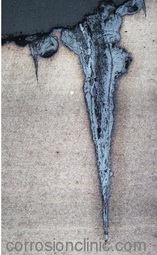For galvanic corrosion to occur, three conditions must all be present: Electrochemically dissimilar metals must be present. It is the aim of this chapter to provide the reader with the knowledge and data to aid in recognizing this form of corrosion when it occurs and making the right design decisions to prevent it. It occurs when two (or more) dissimilar metals are brought into electrical contact under water.
In America, it was proposed that the drinking water was getting contaminated with lead due to galvanic corrosion taking place between copper and lead in the pipes. To prevent this authorities decided to use some insulating materials which can prevent galvanic corrosion. Breaking the electrical connection by insulating the two metals from each other. Applying coatings to both materials.
The coating on the cathode is the most important and must be in good condition, otherwise the galvanic corrosion could be worsened. The more noble metal drives the c. There are four elements necessary for corrosion to occur in a galvanic cell: Anode - The electrode where galvanic reaction(s) generate electrons - negative ions are discharged and positive ions are formed.
Cathode - The electrode that receives electrons - positive ions are discharge negative ions are formed. Corrosion occurs at the anode. The less noble material will corrode first if there is an electrolyte present.
For this corrosion to start, there need to be three things: an anode (one metal), a cathode (a second metal), and an electrolyte (water is a common one). Le ultime tendenze al miglior prezzo dai vostri negozi preferiti. Tieniti sempre aggiornato!
The noble metal can be any metal that has lesser reactivity compared to aluminium. Reactivity of a metal depends on its position in the electrochemical series. It is the aim of this article to provide the reader with the knowledge and data to aid in recognizing this form of corrosion when it occurs and making the right design decisions to prevent it.
For example, galvanic corrosion occurs when screws and fasteners used in an equipment are made of a different material than the one they are connecting. Ad esempio, la corrosione elettrochimica diventa di massimo interesse quando le viti utilizzate in un macchinario sono di materiale diverso da quello che devono collegare. Environmental factors (such as electrolyte concentrations, flow rates, and temperatures) can further.
That is to say, it occurs as a result of the flow of very small electric currents usually between two dissimilar metals which causes the more anodic of the two metals to corrode, the noble or cathodic metal being unaffected. Countermeasures to prevent its formation must be taken into consideration at the conceptual or early stages of the design process. Essentially, a galvanic cell channels the electrical energy produced by the electron transfer in a redox reaction.
The galvanic current ( corrosion ) is directly proportional to the cathodic area when the cell is under cathodic control as it normally is in water. Conductivity plays a major role by limiting galvanic corrosion to the immediate area of contact in low conductivity fresh water and by spreading the galvanic effect over rather large areas in highly conductive waters such as seawater.
Metals further apart on the Galvanic Scale (or with greater electrode potential) are at higher risk of galvanic corrosion. Galvanic corrosion requires two dissimilar metals, in electrical contact, in the presence of an electrolyte to occur.
Metals close to one another on the chart generally do not have a strong effect on one another, but the farther apart any two metals are separate the stronger the corroding effect on the one higher in the list. This article highlights a galvanic corrosion problem often seen in industry and sometimes missed by the person selecting equipment.

This corrosion can occur when connecting stainless steel to aluminum, carbon steel or other types of metals and it is one of the most common and destructive forms of corrosion. When galvanic corrosion occurs, it is due to the difference in electrode potential because one of the metals becomes the anode and the other the cathode. Factors such as relative size of anode, types of metal, and operating conditions ( temperature, humidity, salinity, etc.) affect galvanic corrosion.
Most designers know enough to be dangerous, but how exactly does galvanic corrosion work, and what are the best practices for preventing it? Metal compatibility: galvanic corrosion. Sometimes it may have raised doubts about the use of brass accessories together with other metal pipes, for the possible harmful effects on the installation.
An effect that may occur is a corrosion known as galvanic corrosion, which may happen with the contact of two dissimilar metals in the presence of an electrolyte or conductive media, such as water. Similar to the process for producing electricity in batteries, the dissimilar metals will have different electrode potentials and so, when in contact, one metal will behave as an anode and the. The corrosion of the base metal is not increased by the fastener.

The chart below shows how different plating materials react to one another with regard to their galvanic potential.
Nessun commento:
Posta un commento
Nota. Solo i membri di questo blog possono postare un commento.